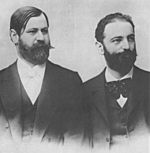Wilhelm Fliess facts for kids
Quick facts for kids
Wilhelm Fliess
Wilhelm Fließ |
|
|---|---|

Fliess (right) and Sigmund Freud
in the early 1890s. |
|
| Born | 24 October 1858 Arnswalde, Province of Brandenburg, Kingdom of Prussia
|
| Died | 13 October 1928 (aged 69) Berlin, Province of Brandenburg, Germany
|
| Nationality | Prussian |
| Scientific career | |
| Fields | Otolaryngology |
Wilhelm Fliess (born October 24, 1858 – died October 13, 1928) was a German ear, nose, and throat doctor. He worked in Berlin. He created some ideas, like the "biorhythm" theory, which are not accepted by scientists today. He is mostly remembered for being a close friend and working partner with Sigmund Freud, a famous psychologist.
Contents
His Work and Friendship with Freud
Fliess developed some unique ideas, such as "vital periodicity." This was an early version of the popular idea of biorhythms. His work was not widely accepted by scientists.
Fliess met Sigmund Freud in 1887 in Vienna. They quickly became close friends. They wrote many letters to each other and met often. Fliess played an important part in the early development of psychoanalysis, which is a way to understand the human mind. Fliess and Freud even worked together on a project called Project for a Scientific Psychology, but they later stopped working on it. Fliess wrote about his biorhythm ideas in a book called Der Ablauf des Lebens.
A Difficult Medical Case
A patient named Emma Eckstein had a very tough experience with Fliess. Freud sent her to Fliess for surgery on her nose. The surgery was meant to help her with feeling very sad before her period. After the surgery, Emma had a lot of bleeding and got an infection. She almost died. Freud then found another surgeon who discovered that Fliess had left a piece of surgical gauze inside her nose. Emma's face was changed forever because of this. Even so, she remained friends with Freud for many years. She even became a psychoanalyst herself.
Fliess and Freud stayed close friends for a while. Fliess even tried to predict Freud's death using his complex number theories. However, their friendship ended in 1904. Fliess believed that Freud had shared details of a theory he was working on with someone else. Freud lived to be 83 years old, much longer than Fliess had predicted.
Freud wanted all his letters to Fliess to be destroyed. But a woman named Marie Bonaparte bought Freud's letters to Fliess and saved them. This is why we know about their friendship today.
About His Life
Wilhelm Fliess was born in a town called Arnswalde, which was in Prussia (now Poland). This was on October 24, 1858.
His son, Robert Fliess, also became a psychoanalyst. He wrote many books in that field. He created the term ambulatory psychosis.
His niece, Beate Hermelin, was a psychologist in the UK. She made important discoveries in how the brain develops and thinks.
What People Think of His Ideas Today
Most scientists today do not agree with Fliess's theories. His idea about a connection between the nose and private parts was popular for a short time in the late 1800s. But it disappeared from medical books within ten years.
Most scientists who have studied biorhythms believe that this theory cannot predict anything better than pure chance. They see it as an example of pseudoscience, which means it looks like science but isn't based on real scientific methods.
Some people, like Martin Gardner, have said that Freud's willingness to consider Fliess's unusual ideas makes them question psychoanalysis itself.
Fliess appears as a character in a 2010 novel called A Curable Romantic by Joseph Skibell. The story of Freud and Fliess's relationship was also told by Martin Gardner in a magazine column in 1966.
See also
 In Spanish: Wilhelm Fliess para niños
In Spanish: Wilhelm Fliess para niños

